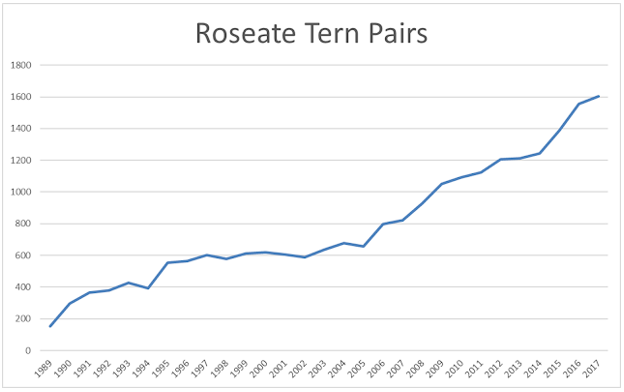Location:
Rockabill is a small island (0.9ha) situated 7 km off the coast of north County Dublin, east‐north‐east of the coastal town of Skerries. It consists of two small granite islets separated by a narrow channel. The Lighthouse Island (the larger of the two islets, also known as The Rock) lies to the south and has to date supported the majority of breeding Roseate and Common Terns, while the other islet, The Bill, has held the majority of Arctic Terns.
Rockabill is a small island (0.9ha) situated 7 km off the coast of north County Dublin, east‐north‐east of the coastal town of Skerries. It consists of two small granite islets separated by a narrow channel. The Lighthouse Island (the larger of the two islets, also known as The Rock) lies to the south and has to date supported the majority of breeding Roseate and Common Terns, while the other islet, The Bill, has held the majority of Arctic Terns.
Breeding Bird Species:
Rockabill supports the largest breeding population of roseate terns in Europe. There were 180 pairs in 1989 on Rockabill and since management has been implemented, the population has been recovering. In 2018, 1642 roseate Tern primary nests were counted on Rockabill making it the highest recorded to date.
Rockabill supports the largest breeding population of roseate terns in Europe. There were 180 pairs in 1989 on Rockabill and since management has been implemented, the population has been recovering. In 2018, 1642 roseate Tern primary nests were counted on Rockabill making it the highest recorded to date.
The islets also support common terns (2039 pairs in 2018), Arctic terns (59 pairs in 2018), black-legged kittiwakes (133 pairs in 2018) and black guillemots (68 pairs in 2018).
Partnership:
Rockabill is owned by the Commissioners of Irish Lights. It is used exclusively for nature conservation and as a base for a lighthouse. The Rockabill Tern Project has been running since 1989 meaning that 2018 was the 30th season of full‐time wardening. The conservation of Roseate Terns on Rockabill is a joint project between BirdWatch Ireland and the National Parks & Wildlife Service (of the Department of Culture, Heritage and the Gaeltacht) since 1989. Since 2016, funding has been provided by both the EU LIFE Nature (LIFE14NAT/UK/000394) and NPWS.
Presence of the LIFE Project:
The LIFE Project aims to increase the nest density and therefore colony size on Rockabill. This involves managing the habitat by clearing the vegetation and creating more terraces to maximise nesting areas for the terns. New management measures are being implemented to reduce predation through using loud-speakers to scare gulls and other techniques. In addition, the added funding will allow the wardens to start preparing the site earlier and finishing later in the autumn.
Rockabill is owned by the Commissioners of Irish Lights. It is used exclusively for nature conservation and as a base for a lighthouse. The Rockabill Tern Project has been running since 1989 meaning that 2018 was the 30th season of full‐time wardening. The conservation of Roseate Terns on Rockabill is a joint project between BirdWatch Ireland and the National Parks & Wildlife Service (of the Department of Culture, Heritage and the Gaeltacht) since 1989. Since 2016, funding has been provided by both the EU LIFE Nature (LIFE14NAT/UK/000394) and NPWS.
Presence of the LIFE Project:
The LIFE Project aims to increase the nest density and therefore colony size on Rockabill. This involves managing the habitat by clearing the vegetation and creating more terraces to maximise nesting areas for the terns. New management measures are being implemented to reduce predation through using loud-speakers to scare gulls and other techniques. In addition, the added funding will allow the wardens to start preparing the site earlier and finishing later in the autumn.
Bibliography:
Acampora, H., Ní Dhonnabháin, L., Miley, D. & Newton, S.F. 2018. Rockabill Tern Report 2018. BirdWatch Ireland Seabird Conservation Report.
LIFE (2015) LIFE Nature and Biodiversity Technical Applications Forms. Part A - Administrative information. EU LIFE Roseate Tern Recovery Project
Acampora, H., Ní Dhonnabháin, L., Miley, D. & Newton, S.F. 2018. Rockabill Tern Report 2018. BirdWatch Ireland Seabird Conservation Report.
LIFE (2015) LIFE Nature and Biodiversity Technical Applications Forms. Part A - Administrative information. EU LIFE Roseate Tern Recovery Project




